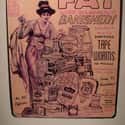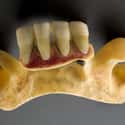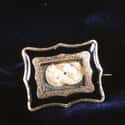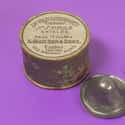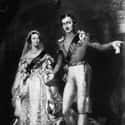-
(#1) Eating Cornflakes So You Aren't Tempted To Play With Yourself
In the 19th century, cornflakes (not just any brand, but Kellogg's Corn Flakes, specifically) were a must-eat item when it came to curtailing libidinous energy. Indeed, it was John Harvey Kellogg himself who described his famously wholesome breakfast cereal as a "healthy, ready to eat anti-masturbatory morning meal," which meant that it was good form for any well-bred gentleman to be seen consuming it.
The theory was that lascivious foods bred lascivious habits. What, exactly, is a "lascivious food," you might ask? Basically, anything spicy or excessively rich or flavorful (see: delicious), which meant that things like curry, heavy French sauces, and presumably Bloody Marys (had they been invented at that point) were out. Kellogg's advice to young girls, namely that they douse their clitorises with carbolic acid to "burn off" desire, was equally problematic.
-
(#2) Swallowing Tapeworm Larvae To Maintain A Fashionably Trim Figure
Though voluptuous women with curves were generally celebrated in the Victorian era, the well-bred and fashion-conscious lady still made a modestly "respectable" effort to slim down. And what better way to do that than to let a giant tapeworm devour your fat from the inside out?
This quote explaining the procedure ought to serve to remind us that inserting Lovecraftian monsters into one's system generally isn't the way to go:
You take a pill containing a tapeworm egg. Once hatched, the parasite grows inside of the host, ingesting part of whatever the host eats. In theory, this enables the dieter to simultaneously lose weight and eat without worrying about calorie intake.
That's not all: larvae also helped women to cultivate proper table manners, ostensibly because "a woman would never rise hungry from the table, yet she would continue losing weight." It really makes going to the gym seem not so bad after all.
-
(#3) Wearing Dentures Made From Cadaver-Teeth
A beautiful smile is often the hallmark of a civilized individual, but so are resourcefulness and ingenuity. And what could be more resourceful than harvesting perfectly beautiful (and usable) pearly whites from a cadaver?
Apparently, back in the day, no well-bred (and toothless) Victorian would have been caught without a fine set of dentures made from the teeth of the dear departed. But these secondhand chompers weren't without their drawbacks, especially when they came from questionable donors:
Teeth were frequently acquired from executed criminals, exhumed bodies, dentists’ patients, and even animals, and were consequently often rotten, worn down, or loaded with syphilis. The prospect of an overabundance of young, healthy teeth to be readily pillaged from the battlefield must have been a dentist’s dream.
A dentist's dream, perhaps, but a regular person's nightmare.
-
(#4) Using Sex Techniques To Avoid Having Ugly Kids
Listless, passionless sex and loveless marriage weren't just inadvisable because they were bound to lead to emotional unhappiness. As the Daily Mail put it:
Crucially, any union without true love... would bring forth ‘ill-looking, sour and spiritless offspring,' while those hoping for good-looking children should remember that sex must not be ‘faintly or drowsily performed.'
Making love on the stairs was also a bad idea, as a child "that was begat upon a set of stair is most likely to be born with a crooked back, and given in no small way to the fault of staring." Moral of the story: if you want catalog-model kids who don't keep their eyes fixed on anyone for longer than five seconds, do it with vigor and élan.
-
(#5) Sleeping With Raw Meat Lashed To Your Face
In the Victorian era, there was nothing like plastering a piece of flesh to your flesh, and hoping that its "youthful" essence would infiltrate your own. Apparently, wrinkles that resulted from harsh freckle-eliminating methods (like steeping one's skin in carbolic acid) could be counteracted by sleeping with raw steak on one's face, or by smearing "any animal fat on the skin — sheep’s fat, veal, lard."
After all, a well-bred lady always aimed for a snow white complexion (tans were low-class and a sign that one labored outside like a common peasant), and if it took a sacrificial lamb to maintain said whiteness, so be it. Something to keep in mind (and on your face), before you shell out $50.00 for that anti-aging elixir.
-
(#6) Weaving Your Dead Husband's Hair In With Your Own And Wearing It As Jewelry
During the Victorian era, a fashion-conscious mourning woman was always ready to shear off a lock of her deceased husband's tresses to wear as a piece of jewelry. Though the initial stages of mourning called for nothing but heavy black veils and shrouds, one could eventually "graduate" into donning sentimental keepsakes. Indeed, hair jewelry eventually transitioned into an everyday accessory, as "wreaths made from the hair" of the departed were "objects of mourning, while wreaths made from the hair of multiple people... were more like sentimental family trees."
It was a pretty romantic and poignant tradition, actually, and not so different than the contemporary trend of tattooing yourself with loved ones' ashes mixed with ink.
-
(#7) A Slow Demise For Beauty
There seems to be a widespread misconception that respectable women in Victorian times eschewed cosmetics, but in truth, they merely cut corners by "discretely" ingesting their beauty regiments. According to National Geographic, "In the late 19th century, U.S. newspapers advertised tins of wafers that, if eaten, promised to remove freckles, pimples, and other facial marks. These products contained poison, but that wasn’t a secret — it was right on the label, which read 'Arsenic Complexion Wafers.'"
The long-term results of this (and of its topical counterpart, lead foundation) did create a fashionable (if deadly) pallor; but also things "like skin discoloring, hair loss, and rotted teeth." The upshot: vampire chic is glamorous, making yourself look like a cadaver is not.
-
(#8) Wearing Nipple Shields
Though breastfeeding was generally left to wet nurses back in the day (at least in upper-class households), the well-bred biological mother was also known to occasionally participate. But not without the discrete, and proper, aid of a nipple shield. Said device was customarily:
Made from a variety of materials in the 18th and 19th centuries, wood, ivory and silver [being] the most common... the dangers of lead poisoning were well known when these were manufactured in the mid-19th century. They nonetheless came with the assurance that 'They are in no way likely to be injurious to the infant.'
As a result, many infants ended up with lead poisoning, obviously. But nothing beats the whimsically bizarre phrasing of the following advertisement from 1892, which claims that said shields were "easy to wear, holding on like limpets. Sore nipples heal whilst reposing in the bath of milk secreted within the shields." "Reposing in a bath" sounds kind of like a luxurious Calgon come-on, but then again, what's not to love about mother's milk.
-
(#9) Avoiding Inappropriate 'Kissing And Handling'
During the Victorian era, gentlemanly behavior was more or less akin to mailroom etiquette. Single women, for example, "were never to indulge in behavior with a man [that] might lead to being 'kissed or handled in any way.'" This included strict inspection rules, like many of the stipulations that accompany shipping procedures: "If a man wanted to admire a necklace, the woman had to remove it and hand it over for inspection. Under no circumstances was the item to be inspected while she wore it."
There was perhaps something of the old "don't touch a baby bird or its mother will reject it" ethos going on there as well.
-
(#10) Trying Deliberately To Clash With Your Spouse's Hair And Eye Color
Dating in the Victorian era was in some ways akin to the aesthetics of interior decorating, except in reverse. When it came to your paramour, coordinating your hair, eye, and complexion to clash was paramount.
According to guides of the time, for example:
People who had red hair and a flushed complexion were considered to have an excitable and hot tempered personality, so they were encouraged to marry someone with a different temperament, such as someone with jet-black or brown hair... and people were told to never marry someone with the same eye color as they have.
Two redheads marrying? Out of the question.
-
(#11) Passing Out To 'Express' Yourself
The Victorian custom of swooning (in response to bad news, moral scandal, or just about anything that was deemed too unseemly to be handled) was actually way ahead of its time, in its way: 100 years later, gaggles of teens would be doing the very same thing over the Beatles, Charles Manson, and Elvis (et al). According to some theories, though, there was more to it than that.
Passing out wasn't so much about being overwhelmed as it was about expressing oneself in a socially acceptable fashion. In the Victorian era, such "bodily extremities" were all some women had, and even though the custom wasn't as effective as, say, throwing up on someone, it got the message across.
New Random Displays Display All By Ranking
About This Tool
The people of the Victorian era were known for their rigid, stubborn, and mean image. As a member of the upper-class society in Victorian England, you must thoroughly understand all the etiquette rules that fit your status and fame, especially royal family and aristocracy. It seems that many Victorian etiquettes are so absurd and stupid for modern society, but some are also still in use today.
In the Victorian era, etiquette reduced a lot of trouble in interpersonal communication, such as making new friends, keeping in touch with old friends, and even cutting off contact with friends with bad behaviors, these have rules that must be followed. The random tool introduced 11 weird Victorian etiquette rules you did not know.
Our data comes from Ranker, If you want to participate in the ranking of items displayed on this page, please click here.












